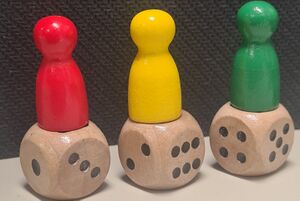God throws dice!
This game is aimed at understanding how a photon is allowed to pass through a polariser, and is based on the random character of quantum mechanics. The board is available at the following link.
It can be played individually, where one player moves all three pieces simultaneously, but it's more fun with up to three participants playing and a dozen watching... Nobody wins in the end, but everyone gains ‘knowledge’.
Introduction
In one of Einstein's letters to Max Bohr, two renowned scientists, Einstein asks himself: ‘Quantum theory produces a good result, but it hardly brings us closer to the secret of the Creator. In any case, I'm convinced that He doesn't play dice.’ ‘’sic‘’. But is the random (stochastic) process of quantum physics really like that? Apparently when we play dice or roulette we know that ONE roll is completely random, but for LARGE NUMBERS we can predict an average value: for example, playing with two dice, if someone always bets on 7, after many rolls they will win over any other bet!
That's why Einstein believes that ‘Everything is determined, both the beginning and the end, by forces over which we have no control... We all dance to a mysterious melody, intoned from a distance by an invisible “player”.
In other words, even if we accept the random nature of quantum mechanics, physics is determined at some point... This game is designed to show you how close physics is to a game of dice!
Game background
Light has both a wave-like and a quantum nature, as we can describe the physical phenomena of light by interpreting it as a collection of particles. This game is based on an important characteristic of light, its polarization.
Polarizers are materials that only allow each photon to pass through a certain state of polarization: if the photon is in a combination of two states, for example horizontal and vertical, and we see it passing through a polarizer, then it is clear that the photon has the polarization of the orientation of that polarizer. When thinking about a single photon, it is interesting to note that this crossing through the polarizer has a certain probability of occurring depending on the angle of the initial polarization of the light with the polarizers axis. This probability is shown to be equal to the square of the cosine of this angle.
In fact, if the polarizer is at 90º, this probability is zero, i.e. all the light is blocked, and if it is aligned at 0º, it is 100%, i.e. all the light passes through it. For intermediate values, in this game, we'll make a proportionality between the angle and the values of the sum of three dice that we know varying between 3 and 18. As our dice don't start from zero, we'll associate the value 2 with zero and 18 with 90º. In this way, if the photon encounters a polarizer aligned with its state, its angle is 0º and, when we roll the dice, we always get a value greater than 2, so the photon is never absorbed by the polarizer, i.e. it always passes through it. On the other hand, if it's at 90º, any roll of the dice will never be higher than 18 and consequently it will never get through the polarizer. In an intermediate range of values, we'll make the corresponding proportionality, i.e. a value of 45º will correspond to obtaining a throw of more than 10. For lower angles, the requirement is lower, i.e. for 22.5º it will be 6 and for 11.25º it will be 4.
The optical path
In this game we have three paths or tracks (P2, P4 and P8) that cross 2, 4 or 8 polarisers. We also consider that the polarisers divide the right angle into equal parts, for example, on track P2 they are positioned at 45º to each other and on track P8 each one is 11.25º away from its antecedent. This is why the probability of passage varies according to the figure below. On each polariser, the photon pawn has to roll the dice to cross it and try to reach the finish line... or be rejected, which is equivalent to being absorbed into the polariser! Each pawn represents a photon travelling through space, crossing a set of polarisers described as the passing condition on the board (♦️). Three photon pawns start simultaneously at the beginning of the game but then travel independently, creating their own statistics, which are calculated at the end of the game. When they hit a target, they are repositioned in the game, starting a new journey as a reborn photon.
The game
This game is collaborative between a large number of participants, although it is played individually in turn, and aims to demonstrate the random nature of quantum physics. The more participants who play, the better the statistics will be and the closer we will be to the expected physical result. This can be achieved with several tables and boards and by adding up the results at the end. Each player is responsible for managing a certain number of photon pawns (in principle one, but there may be variants of the game in which each player plays on simultaneous tracks) and associates them with a track of a certain colour. The game ends when you want it to, but ideally you should have at least 10 photons on each final square (Absorbed and Transmitted). By filling in the final data in a table, we can calculate the ratio between the photon pawns that crossed the cascade of ‘polarisers’ and the total photons in play for each initial optical path.
After the game, you can carry out the experiment in the remote-controlled laboratory with multiple polarisers, in the link below, experimentally verifying the results obtained for the path with two and four polarisers.

